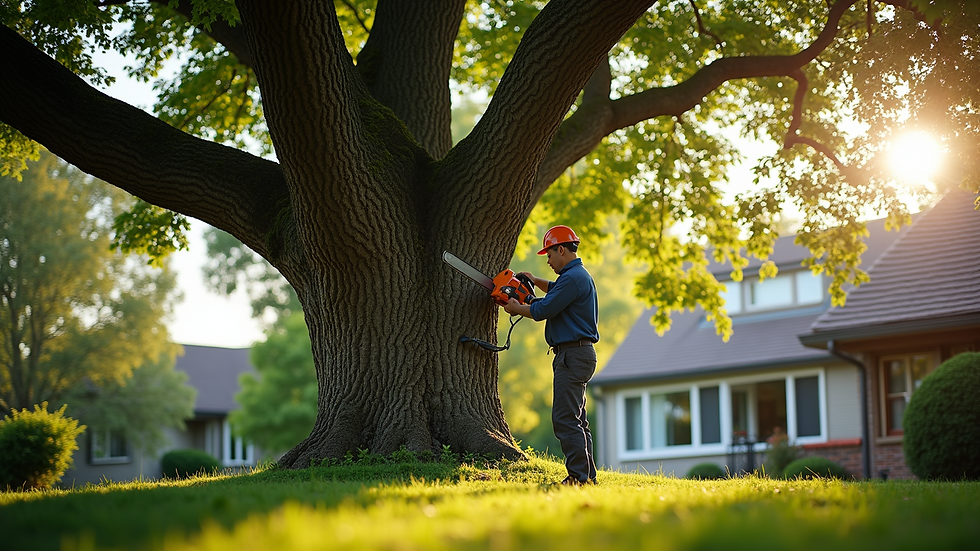Seasonal Factors when Choosing the Right Time for Tree Felling
- Garrett Looney
- May 1, 2024
- 3 min read
With tree felling, there are several important factors to consider, and one of the most crucial is the timing. Trees are a valuable part of our environment, and responsible tree removal is essential to ensure safety and maintain the ecosystem's balance. If you're considering tree felling, it's essential to understand the seasonal considerations that can impact your decision.
Below, we explore the best times for tree felling, taking into account the unique conditions and challenges that each season presents.
Spring; A Season of Growth
Spring is a season of renewal and growth for trees. As the temperatures rise and the days lengthen, trees come out of their winter dormancy and begin to produce new leaves and shoots. While this period may seem like an ideal time for tree felling, there are some important considerations to keep in mind.
In spring, dead trees are often more apparent because they may not sprout new leaves or buds, making them stand out among the thriving greenery. Not only that, but spring tree felling may have a lower impact on wildlife compared to other seasons, as many animals are still in the process of nesting or raising their young.
On the other hand, there are some downsides to tree felling in spring, including the increased sap flow in trees at this time. Felling a tree during this time can result in more sap bleeding, which may affect the quality of the wood and create messier work conditions. Another disadvantage of felling trees in spring is the potential for the regrowth of the felled tree.
Some tree species have a strong tendency to regrow if cut in the spring. This can lead to additional work and maintenance to prevent regrowth.
Summer; A Balancing Act
Summer is a popular time for outdoor activities and landscaping, making it an attractive season for tree felling. However, the hot and dry conditions can pose challenges for this task.
Although summer generally offers stable weather conditions, making it easier to plan and execute tree felling operations and the dry ground and fewer obstacles, such as snow or mud, can make it easier to access the tree and remove debris, you are more likely to be faced with drought stress and increased wildlife activity at this time.
Depending on the location, summer can bring drought conditions that may stress trees further. It's essential to consider a tree's health and water needs before felling. Not only that, but summer is a peak period for wildlife activity. Felling trees during this time can disrupt nesting birds and other animals, necessitating additional precautions.
Autumn; Falling Leaves and Cooler Days
Autumn, with its cooler temperatures and falling leaves, is often seen as an ideal time for tree felling. It provides unique advantages and some distinct challenges. In this season, deciduous trees shed their leaves in autumn, making it easier to assess the tree's structure and plan the felling process and the cooler weather conditions can be more comfortable for tree fellers, reducing the risk of heat-related illnesses.
With that being said, there are in fact some disadvantages to tree felling in the autumn season too. Autumn can bring unpredictable weather patterns, including rain and early frost. These conditions can impact the work schedule and safety. It is also important to consider that if tree felling is left till late autumn, wildlife could be preparing for the winter. Ensure that your tree felling activities do not disturb hibernating animals or disrupt their natural behaviours.
Winter; Cold and Dormant
Finally, we have the winter season. Winter is often considered the least ideal season for tree felling due to the cold weather and dormant state of many trees. However, it can still be a viable option under certain circumstances.
Deciduous trees are dormant during the winter, which can make it easier to work on them without leaves obstructing your view and wildlife activity is generally lower during the winter months, reducing the chances of disturbing animals.
This of course comes with its obvious downsides like the weather conditions. Cold temperatures, snow, and ice can create hazardous conditions for tree felling. Specialised equipment and safety measures are essential and the ground may be frozen, making it more challenging to remove the tree's stump and roots.
In conclusion, choosing the right time for tree felling requires careful consideration of the unique conditions and challenges each season presents. While each season has its advantages and disadvantages, it's crucial to prioritise safety, environmental responsibility, and compliance with local regulations. That is why it is important to reach out to our professionals at Bennett’s Tree Care. Simply visit our website or get in contact with us directly by phone on 0800 612 6486, by email at info@bennettstreecare.co.uk or via our online contact form.


.webp)



Comments